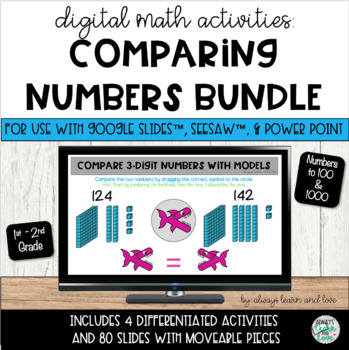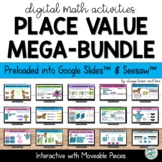Comparing Numbers to 100 and Numbers to 1000 Bundle for Seesaw™ Google Slides™
- Zip
- Google Apps™

Products in this Bundle (2)
Also included in
- This collection of numbers to 100 and numbers to 1000 digital math activities is pre-loaded and ready to use with Seesaw™ and Google Slides™ for 1st grade and 2nd grade students for number sense skills ideal for Distance Learning and Homeschool. Students learn and practice 2-digit and 3-digit numbPrice $65.79Original Price $85.26Save $19.47
Description
Pre-loaded and ready to use with Seesaw™ and Google Slides™, 1st grade and 2nd grade students develop the conceptual understanding for 2-digit numbers and 3-digit numbers with place value digital activities ideal for Distance Learning and Homeschool. Students practice comparing and contrasting numbers to 100 and 1000. The activities are differentiated and include digital manipulatives for a conceptual understanding of numbers to be used at home or at school.
If you provide distance learning as a teacher or parent, integrate digital learning in your classroom, or homeschool, these interactive Seesaw™, Google Classroom™, PowerPoint, and PDF activities are perfect for you. They would work well for independent work, home learning, non-traditional instruction, intervention, and RTI. Each of the activities comes in all 4 formats listed below and can easily be uploaded to Microsoft, Nearpod, and other online platforms.
Information:
Seesaw™: These activities are preloaded into Seesaw and, by clicking on a link provided, will automatically download to your Seesaw Activity Library with all of the icons, shortcuts, and directions included. There is no need to create anything as these activities are ready to assign to students. All directions are included.
Google Classroom™: Download these files directly into your Google Classroom or Slides account and assign to students by clicking on a link provided. There is no need to create anything as these activities are ready to assign to students. All directions are included.
PowerPoint and PDF: The files are ready for you to open, use, and easily upload to Microsoft or Nearpod.
About the Activities
Each of the 4 activities comes with an instructional slide (including key vocabulary terms) and an example slide so students know exactly what to do, and they contain 18 practice slides each for students to complete using engaging and interactive styles such as moveable parts and digital manipulatives.
1. Compare 2-Digit Numbers With Models: Students are introduced to the vocabulary terms of compare and contrast. Models of each two-digit number are provided and students drag the greater than or less than shark or equal sign to compare the numbers. The visual representation is ideal for students new to the concept, students in need of additional practice, and those in need of support.
2. Compare 2-Digit Numbers: Students are introduced to the vocabulary terms of compare and contrast. A place value chart shows each two-digit number and students drag the greater than or less than shark or equal sign to compare the numbers. This activity is ideal for students on grade level.
3. Compare 3-Digit Numbers With Models: Students are introduced to the vocabulary terms of compare and contrast. Models of each three-digit number are provided and students drag the greater than or less than shark or equal sign to compare the numbers. The visual representation is ideal for students new to the concept, students in need of additional practice, and those in need of support.
4. Compare 3-Digit Numbers: Students are introduced to the vocabulary terms of compare and contrast. A place value chart shows each three-digit number and students drag the greater than or less than shark or equal sign to compare the numbers. This activity is ideal for students on grade level.
Included in this Bundle:
This Bundle is also part of the Place Value Mega Bundle, available HERE.
You May Also Like:
Numbers to 100 Place Value Bundle
Numbers to 1000 Place Value Bundle
Expanded Form of 2 & 3 Digit Numbers Bundle
* Click HERE to follow my store.
*This purchase is for SINGLE USE ONLY. To share with other teachers or teammates, an additional license will need to be purchased. If you have any questions, please contact me at alwayslearnandlove@gmail.com.
* Click HERE to leave feedback on a resources and receive TpT credit.
Thanks,
Kim Naiman






